-
1011
Description: Rectangular shape with cavetto-moulded edging; top centre, initials in triad with date below; on each side, stamp formed of a small, wavy-arched rectangular fireback bearing a lion rampant between pilasters surmounted by burning cauldrons, beneath two mirrored putti holding branches; beneath the date, a stamp formed of a small arched-rectangular fireback laid on its left side with a burning cauldron on each shoulder and the faint figure of a bird in the centre.
Notes: The two identical fireback stamps on either side of the inscription have been noted elsewhere (see no. 210 Late Pictorial series 5); the centre and right fireback stamps have been impressed insufficiently; illustration from Country Life advertisement by T. Crowther & Son Ltd, 18 Oct 1984.
Inscription: TFE [triad] / 1701
- Decoration tags:
- rectangular (shape)
- cavetto (edging)
- composite
- individual letters
- individual numbers
- pictorial
- architectural
- text
- animals
Manufactured: in 1701 in England.
Current location: not known.
- Attached to series:
- Composite firebacks
- Late pictorial series (all)
- Late pictorial series 5
-
1025
Description: Quasi-rectangular shape; top, crowned robed statuary figure holding a book, repeated three times, interspersed with a naked child statuary figure playing a flute; bottom, shield and coronet to left, small shield, helm and crest to right, all between a crude dog figure repeated on each side; the whole plate dotted randomly with a repeated small gadrooned bead stamp.
Notes: The figures are from wall-mounted statuary. The shield and coronet are those of the Duchy of Lorraine prior to 1538; blazon: Quarterly, 1. barry of eight gules and argent (Hungary) impaling azure semy-de-lis Or a label gules (Naples); 2. argent a cross potent and four crosslets Or (Jerusalem) impaling Or four pallets gules (Aragon); 3. azure semy-de-lis Or a bordure gules (Valois-Anjou); 4. azure crusilly fitchy, two barbels addorsed Or (Bar); overall an inescutcheon Or a bend gules three alerions argent (Lorraine). The figure holding the book is that of St Catherine of Siena (see von den Driesch, pp. 220, 222).
Arms: Duchy of Lorraine
- Decoration tags:
- rectangular (shape)
- none (edging)
- carved stamps
- heraldic
- historical
- armorial
- animals
- humans
- objects
Manufactured: in the early-16th century in the Lorraine area of Germany.
Current location: not known.
- Attached to series:
- Foreign armorial firebacks
-
44
Description: Rectangular; astragal edging; simple diamond pattern covering whole plate, formed from evenly-spaced diagonal lines.
- Decoration tags:
- rectangular (shape)
- astragal (edging)
- whole carved pattern
- objects
Manufactured: .
Current location: in private hands, Cuckfield, West Sussex, England.
- Attached to series:
- Miscellaneous pattern firebacks
-
45
Description: Rectangular; ovolo-moulded, gadrooned edging (top and sides); a vertical spindle or chair leg surmounted by a fleur-de-lys arranged three times; the date split by the middle fleur-de-lys.
Notes: The fleur-de-lys is separately stamped from the spindle, and the same spindle is seen on another fireback of the same date.
Inscription: 1641
- Decoration tags:
- rectangular (shape)
- gadrooned (edging)
- simple stamps
- carved stamps
- individual numbers
- heraldic
- text
- objects
Manufactured: in 1641 possibly at Cuckfield Furnace in the Weald area of England.
Current location: in private hands, Cuckfield, West Sussex, England.
- Attached to series:
- Spindle series
- Spindle/distaff firebacks
- Fleur-de-lys firebacks
-
935
Description: Carved wooden fireback pattern. Rectangular shape with fillet edging; pictorial scene with three nymphs playing cymbals and tambourine, and dancing in the shade of two trees, with three satyrs play pipes behind; a jug stands on a pedestal; in the foreground a putto fills a jug from a barrel.
Notes: From the Fonderie Salan, Dammarie-sur-Saulx (Meuse).
- Decoration tags:
- rectangular (shape)
- fillet (edging)
- whole carved pattern
- planklines
- pictorial
- mythological
- humans
- plants
Manufactured: in the 18th century in France.
Current location: not known.
- Attached to series:
- Patterns
-
268
Description: Rectangular; cavetto moulded edging; shield, garter, coronet, helm, crest, supporters and motto of Villiers, 1st Duke of Buckingham.
Notes: The arms are those of George Villiers (1592-1628), created Duke of Buckingham in 1623. Blazon: Quarterly 1, Villiers (modern) - argent, on a cross gules five scallops or; 2, Villiers (ancient) - sable, a fess between three cinquefoils argent; 3, Pakeman - gules, a chevron between three crosses botonnee fitchee argent; 4, Bellers - per pale gules and sable, a lion rampant argent crowned or; 5, Hoby - azure, a bend between six mullets argent; 6, Kirkby - argent, a cross between two annulets vert.
Copies of this fireback are known.
Inscription: HONI SOIT QVY MAL Y PENSE / FIDEI COTICULA CRUX [The cross is the touchstone of faith]
Arms: George Villiers, 1st Duke of Buckingham
- Decoration tags:
- rectangular (shape)
- cavetto (edging)
- whole carved pattern
- planklines
- armorial
Manufactured: in the early-17th century in England.
Current location: not known.
Citation: Dawson, C., 1903, 'Sussex Iron Work and Pottery', Sussex Archaeological Collections, 46, pp. 1-54.
- Attached to series:
- Personal armorial firebacks
- Bristol armorial group
-
270
Description: Rectangular; cyma recta moulded edging; centre top, date formed of individual stamps.
Notes: The moulding used for the edging, which was probably derived from redundant furniture, is very similar to that used on several firebacks of a similar style in the late 17th century, although the lettering style is different. Although its small height suggests that this may only be the top half of a fireback, the existence of a plate of similar dimensions in Brighton Museum may indicate that the proportions were deliberate.
Inscription: 1728
- Decoration tags:
- rectangular (shape)
- cyma recta (edging)
- individual numbers
- text
Manufactured: in 1728 in England.
Current location: Dorset County Museum, Dorchester, Dorset, England.
(part of the Dorset County Museum museum group)
- Attached to series:
- Date only firebacks
-
291
Description: Rectangular; astragal with cavetto-moulded edging (top and sides); date top centre; initials evenly-spaced below date; low-relief fleur de lys stamp repeated three times down each side, and in triangular arrangement below initials.
Notes: The initials may relate to William Boevey who was owner of Flaxley furnace from 1683-92. Another fireback with the same date and initials, and fewer fleurs, is also known. Formerly at Flaxley Abbey, Gloucestershire. Dreweatts Auctioneers, Newbury, 3 Oct 2022, lot 183 (£240).
Inscription: 1685 / W B
- Decoration tags:
- rectangular (shape)
- astragal with cavetto (edging)
- carved stamps
- heraldic
- text
Manufactured: in 1685 at Flaxley Furnace in the Forest of Dean area of England.
Current location: not known.
Citation: Bick, D. E. [incorrectly printed as Bick, R.], Sept 1985, 'Firebacks', Period Homes, pp. 21-4.
- Attached to series:
- Boevey series
-
1107
Description: Rectangular shape; ovolo edging (top and sides); top centre, date between two fleurs-de-lys; below, initials spaced apart.
Notes: A small fireback, probably for an upstairs fireplace. Formerly at Cothay Manor, Wellington, Somerset. Auction: Duke's, Dorchester, 7 Sep 2018 lot 585 (£360).
Inscription: 1626 / N M
- Decoration tags:
- rectangular (shape)
- ovolo (edging)
- individual letters
- individual numbers
- heraldic
- text
Manufactured: in 1626 in England.
Current location: in private hands, Wigmore, Herefordshire, England.
- Attached to series:
- Miscellaneous stamp firebacks
-
1100
Description: Quasi-rectangular shape with inward curving sides; twisted rope edging (top and sides); arrangement of fleurs-de-lys: top centre, four in a star formation with two horizontally below; two vertically to left and right; vertical dagger, pommel to base, stamped twice inside outer fleurs.
Notes: A uniquely shaped fireback with fleurs and daggers (each about 35cm long) seen on two other firebacks (no. 595 and no. 660).
- Decoration tags:
- rectangular (shape)
- rope (edging)
- simple stamps
- carved stamps
- heraldic
- objects
Manufactured: in the mid-16th century in the Weald area of England.
Current location: Sackville College, Church Lane, East Grinstead, West Sussex, England.
- Attached to series:
- Royal series
- Knife & Dagger stamp firebacks
- Fleur-de-lys firebacks
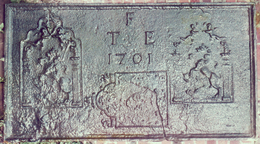
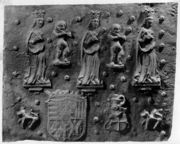
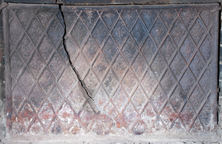

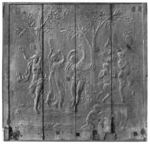
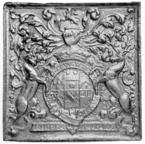
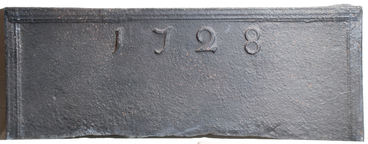
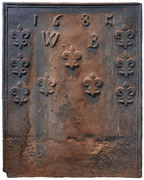
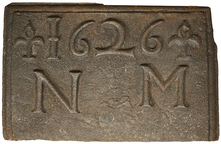
.jpg)